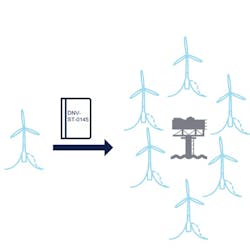DNV preparing second phase of floating offshore substation JIP
Offshore staff
HOVIK, Norway — DNV has completed Phase 1 of its joint industry project (JIP) pursuing new offshore substation standards for the floating wind sector.
Thirty-eight companies are participating including transmission operators, developers, component suppliers, EPCI contractors, and yards.
DNV's 2023 Energy Transition Outlook predicts that global floating offshore wind capacity could exceed 260 GW. Offshore substations act as hubs connecting multiple wind turbines and transmitting renewable energy.
Challenges associated with designing and installing substations are said to include the need for high-voltage dynamic cables and electrical equipment to withstand the movements of the floating structures.
The JIP's Phase 1 has confirmed the feasibility of floating offshore substations and export cables, identifying technology gaps and highlighting the maturity of AC solutions compared to DC.
It is now initiating Phase 2, which will build on the Phase 1 deliverables and the input received from the contributors.
11.06.2023

